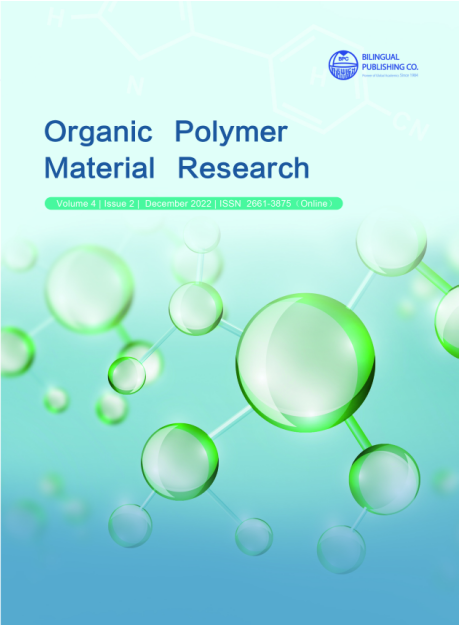N-heterocyclic Carbene Catalysed Polymerisation of 2,5-Diformylfuran
DOI:
https://doi.org/10.30564/opmr.v4i2.4953Abstract
The biobased renewable monomer 2,5-diformylfuran is polymerised using various N-heterocyclic carbene (NHC) catalysts in dimethyl sulfoxide (DMSO) affording a low molar mass polymer. It is shown that catalyst structure as well as the temperature and time the polymerization is running have a noticeable effect on its molar mass. The obtained material is characterized by nuclear magnetic resonance (NMR), thermogravimetric analysis (TGA), differential scanning calorimetry (DSC) and X-ray diffraction (XRD). An attempt at chain extension with diamine leads to precipitation of the polymer. This new biobased polymer material might be useful as a sustainable resin.Keywords:
Biobased polymer, 2, 5-diformylfuran, NHCReferences
[1] Ogale, A.A., Zhang, M., Jin, J., 2016. Recent advances in carbon fibers derived from biobased precursors. Journal of Applied Polymer Science. 133, 45. DOI: https://doi.org/10.1002/app.43794
[2] Cai, C.M., Zhang, T.Y., Kumar, R., et al., 2014. Integrated furfural production as a renewable fuel and chemical platform from lignocellulosic biomass. Journal of Chemical Technology and Biotechnology. 89(1), 2-10. DOI: https://doi.org/10.1002/jctb.4168
[3] Huang, Y.B., Yang, Z., Dai, J.J., et al., 2012. Production of high quality fuels from lignocellulose-derived chemicals: a convenient C–C bond formation of furfural, -methylfurfural and aromatic aldehyde. RSC Advances. 2(30), 11211. DOI: https://doi.org/10.1039/c2ra22008c
[4] Hoydonckx, H.E., Van Rhijn, W.M., Van Rhijn, W., et al., 2007. Furfural and Derivatives. Ullmann’s Encyclopedia of Industrial Chemistry. Wiley-VCH Verlag GmbH & Co. KGaA; Weinheim, Germany. DOI: https://doi.org/10.1002/14356007.a12_119.pub2
[5] Mariscal, R., Maireles-Torres, P., Ojeda, M., et al., 2016. Furfural: a renewable and versatile platform molecule for the synthesis of chemicals and fuels. Energy & Environmental Science. 9(4), 1144-1189. DOI: https://doi.org/10.1039/C5EE02666K
[6] Girka, Q., Estrine, B., Hoffmann, N., et al., 2016. Simple efficient one-pot synthesis of 5-hydroxymethylfurfural and 2,5-diformylfuran from carbohydrates. Reaction Chemistry & Engineering. 1(2), 176-182. DOI: https://doi.org/10.1039/C5RE00004A
[7] Sarmah, B., Srivastava, R., 2019. Selective two-step synthesis of 2,5-diformylfuran from monosaccharide, disaccharide, and polysaccharide using H-Beta and octahedral MnO2 molecular sieves. Molecular Catalysis. 92-103. DOI: https://doi.org/10.1016/j.mcat.2018.11.001
[8] John, G., Nagarajan, S., Vemula, P.K., et al., 2019. Natural monomers: A mine for functional and sustainable materials–Occurrence, chemical modification and polymerization. Progress in Polymer Science. 92, 158-209. DOI: https://doi.org/10.1016/J.PROGPOLYMSCI.2019.02.008
[9] Fache, M., Darroman, E., Besse, V., et al., 2014. Vanillin, a promising biobased building-block for monomer synthesis. Green Chemistry. 16(4), 1987-1998. DOI: https://doi.org/10.1039/C3GC42613K
[10] Cao, L., Yu, I.K.M., Liu, Y., et al., 2018. Lignin valorization for the production of renewable chemicals: State-of-the-art review and future prospects. Bioresource Technology. 269, 465-475. DOI: https://doi.org/10.1016/j.biortech.2018.08.065
[11] Araújo, J.D.P., Grande, C.A., Rodrigues, A.E., 2010. Vanillin production from lignin oxidation in a batch reactor. Chemical Engineering Research and Design. 88(8), 1024-1032. DOI: https://doi.org/10.1016/j.cherd.2010.01.021
[12] Bello, S., Salim, I., Méndez-Trelles, P., et al., 2018. Environmental sustainability assessment of HMF and FDCA production from lignocellulosic biomass through life cycle assessment (LCA). Holzforschung. 73(1), 105-115. DOI: https://doi.org/10.1515/hf-2018-0100
[13] Motagamwala, A.H., Won, W., Sener, C., et al., 2018. Toward biomass-derived renewable plastics: Production of 2,5-furandicarboxylic acid from fructose. Science Advances. 4(1), eaap9722. DOI: https://doi.org/10.1126/sciadv.aap9722
[14] Ma, J., Wang, M., Du, Z.,et al., 2012. Synthesis and properties of furan-based imine-linked porous organic frameworks. Polymer Chemistry. 3(9), 2346-2349. DOI: https://doi.org/10.1039/c2py20367g
[15] Hui, Z., Gandini, A.,1992. Polymeric schiff bases bearing furan moieties. European Polymer Journal. 28(12), 1461-1469. DOI: https://doi.org/10.1016/0014-3057(92)90135-O
[16] Wayne Cooke, A.B., Wagener, K., 2002. An investigation of polymerization via reductive coupling of carbonyls. Macromolecules. 24(6), 1404-1407. DOI: https://doi.org/10.1021/ma00006a029
[17] Amarasekara, A.S., Green, D., Williams, L.D., 2009. Renewable resources based polymers: Synthesis and characterization of 2,5-diformylfuran–urea resin. European Polymer Journal. 45(2), 595-598. DOI: https://doi.org/10.1016/j.eurpolymj.2008.11.012
[18] Pinaud, J., Vijayakrishna, K., Taton, D., et al., 2009. Step-Growth Polymerization of Terephthaldehyde Catalyzed by N -Heterocyclic Carbenes. Macromolecules. 42(14), 4932-4936. DOI: https://doi.org/10.1021/ma900907f
[19] Liu, N., 2013. New polymers synthesis by organocatalyzed step-growth polymerization of aldehydic monomers : polyaldols, linear polybenzoin and hyperbranched polyacetals. DOI: https://tel.archives-ouvertes.fr/tel-01081197
[20] Wöhler, L., 1832. Study on the radical of benzoic acid. Journal of Pharmacy (In German). 3(3), 249-282. DOI: https://doi.org/10.1002/jlac.18320030302
[21] Ukai, T., Tanaka, R., Dokawa, T., 1943. A new catalyst for acyloin condensation. Journal of the Pharmaceutical Society of Japan. 63, 296-300.
[22] Flanigan, D.M., Romanov-Michailidis, F., White, N.A., et al., 2015. Organocatalytic Reactions Enabled by N-Heterocyclic Carbenes. Chemical Reviews. 115(17), 9307-9387. DOI: https://doi.org/10.1021/acs.chemrev.5b00060
[23] Baragwanath, L., Rose, C.A., Zeitler, K., et al., 2009. Highly Enantioselective Benzoin Condensation Reactions Involving a Bifunctional Protic Pentafluorophenyl-Substituted Triazolium Precatalyst. The Journal of Organic Chemistry. 74(23), 9214-9217. DOI: https://doi.org/10.1021/jo902018j
[24] Romanov-Michailidis, F., Besnard, C., Alexakis, A., 2012. N-Heterocyclic Carbene-Catalyzed Annulation of α-Cyano-1,4-diketones with Ynals, Organic Letters. 14(18), 4906-4909. DOI: https://doi.org/10.1021/ol3022287
[25] Enders, D., Breuer, K., Kallfass, U., et al., 2003. Preparation and application of 1,3,4-triphenyl-4,5-dihydro-1H-1,2,4-triazol-5-ylidene, a stable carbene, Synthesis. 8, 1292-1295. DOI: https://doi.org/10.1055/s-2003-39409
[26] Ma, Y., Wei, S., Wu, J., et al., 2008. From mono-triazolium salt to bis-triazolium salt: Improvement of the asymmetric intermolecular benzoin condensation. Advanced Synthesis and Catalysis. 350(16), 2645-2651.DOI: https://doi.org/10.1002/adsc.200800371
[27] Smirnova, N.V., Klushin, V.A., Bezbozhnaya, T.V., et al., 2018. Selective Oxidation of 5-(Hydroxymethyl) furfural to Furan-2,5-dicarbaldehyde with Sodium Nitrite in Phosphoric Acid. Russian Journal of Organic Chemistry. 54(3), 414-418. DOI: https://doi.org/10.1134/S1070428018030077




 Wouter Ruelens
Wouter Ruelens






